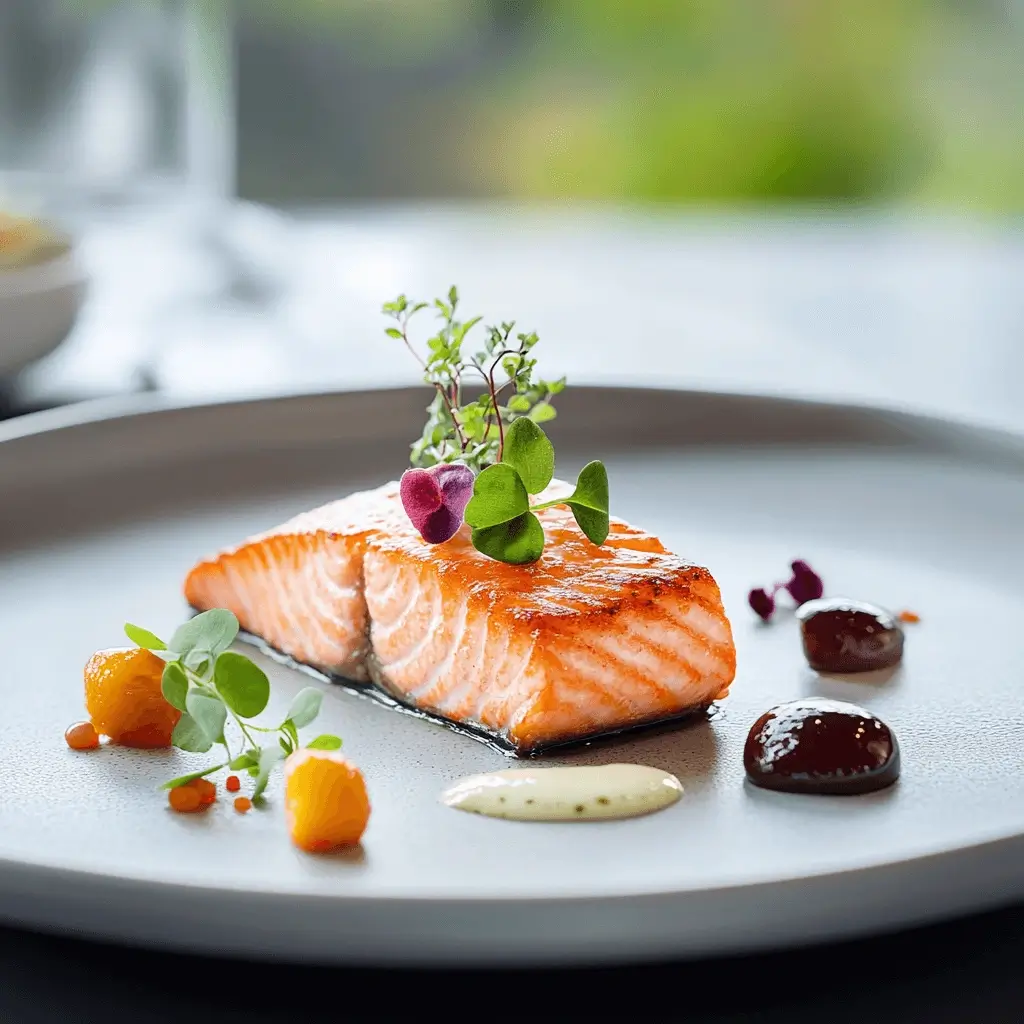Introduction
Keta salmon, also known as chum or dog salmon, is one of the five Pacific salmon species. It is renowned for its mild flavor and firm texture, making it a versatile choice for various culinary applications. Understanding how to select, prepare, and cook keta salmon can elevate your dishes and provide a nutritious addition to your diet.
Understanding Keta Salmon
Keta salmon (Oncorhynchus keta), commonly known as chum salmon or dog salmon, is one of the five main species of Pacific salmon. It is widely distributed in the northern Pacific Ocean, spanning from Alaska and British Columbia to Japan and Russia. Despite being less popular than other salmon varieties like sockeye or king salmon, keta salmon holds a unique place in the seafood market due to its affordability, mild taste, and firm texture.
What is Keta Salmon?
Keta salmon is a species of wild salmon primarily found in the Pacific Ocean. It is known for its extensive migratory patterns, as it hatches in freshwater rivers, spends several years in the ocean, and returns to its birthplace to spawn. This species is among the most widely available and sustainable salmon options, making it a great choice for those looking for nutritious, eco-friendly seafood.
Habitat and Distribution
- North America: Found in the coastal waters of Alaska, British Columbia, and along the U.S. Pacific Northwest.
- Asia: Ranges from the Russian Far East to the coasts of Japan and Korea.
- Migration: Like other salmon species, keta salmon migrates from freshwater rivers to the open ocean, where it grows and matures before returning to freshwater streams for spawning.
Distinguishing Features
Keta salmon has several unique physical and biological characteristics that set it apart from other salmon species:
- Color and Appearance: In the ocean, keta salmon has a silvery-blue hue with faint vertical bars along its body. As it approaches spawning season, its coloration changes to olive-green or reddish-purple with bold vertical stripes.
- Size and Weight: Keta salmon typically measures between 8-15 pounds (3.6-6.8 kg) and can grow up to 3.5 feet (1 meter) in length.
- Fat Content: Compared to other salmon species, keta salmon has a lower fat content, giving it a leaner texture and a milder flavor.
- Teeth: The species gets the nickname “dog salmon” due to the presence of large, canine-like teeth, which males develop during spawning.
Nutritional Profile
Keta salmon is a powerhouse of essential nutrients, making it an excellent addition to a balanced diet. It is a lean source of protein and packed with omega-3 fatty acids, which provide numerous health benefits.
Macronutrient Breakdown (Per 100g serving):
- Calories: ~120 kcal
- Protein: ~22g
- Fat: ~3-4g
- Carbohydrates: 0g
- Omega-3 Fatty Acids: ~1g
Health Benefits:
- Rich in Omega-3 Fatty Acids:
- Omega-3s (EPA and DHA) support heart health by reducing inflammation, lowering blood pressure, and decreasing the risk of cardiovascular diseases.
- They also promote brain function, improving cognitive abilities and reducing the risk of neurodegenerative diseases.
- High-Quality Protein:
- With 22 grams of protein per 100g serving, keta salmon helps in muscle growth and repair, making it a great choice for athletes and active individuals.
- Boosts Immune System:
- Keta salmon is a rich source of selenium and vitamin B12, which contribute to immune function and overall well-being.
- Selenium serves as an antioxidant, defending cells against damage.
- Supports Bone Health:
- The high levels of vitamin D in keta salmon help maintain bone strength by improving calcium absorption.
- Low in Mercury and Sustainable Choice:
- Compared to other seafood, keta salmon has lower mercury levels, making it a safe and healthy option for regular consumption.
- It is widely available through sustainable fishing practices, ensuring minimal environmental impact.
Flavor and Texture
One of the defining characteristics of keta salmon is its mild flavor and firm texture, which make it versatile for various cooking methods.
Taste Profile:
- Mild and Delicate: Unlike sockeye salmon, which has a strong, rich taste, keta salmon offers a subtler and less fishy flavor.
- Slightly Sweet Undertones: Some people describe keta salmon as having a slightly sweet aftertaste, especially when prepared with the right marinades.
Texture and Cooking Suitability:
- Firm and Lean: Since keta salmon has a lower fat content compared to other salmon species like king or Atlantic salmon, its flesh is firmer.
- Less Oily: Because of its leanness, keta salmon requires careful cooking to prevent it from drying out. Proper preparation methods, such as marinating or basting, help retain its moisture.
- Ideal for Multiple Cooking Methods: The firm texture allows keta salmon to hold up well when grilled, roasted, or smoked.
Keta salmon’s versatility and affordability make it an excellent choice for anyone looking to incorporate healthy and delicious seafood into their diet. Understanding its nutritional benefits and best cooking practices can help you make the most out of this flavorful fish.
Preparing Keta Salmon for Cooking
Proper preparation is the key to achieving a flavorful and perfectly cooked keta salmon dish. Since keta salmon is leaner than other salmon varieties, it requires careful handling to maintain its texture and taste. Below are essential steps to ensure the best results.
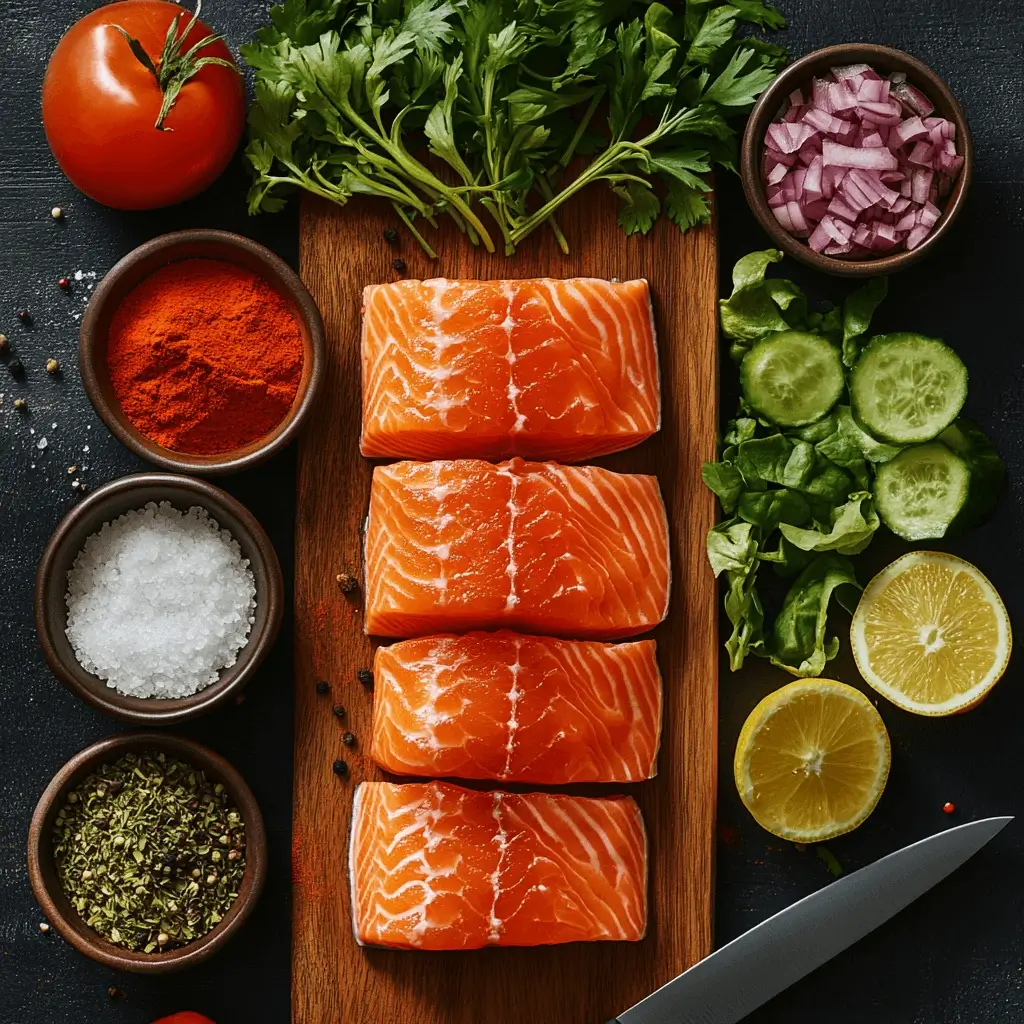
Selecting Fresh Keta Salmon
Choosing high-quality keta salmon is the first step in preparing a delicious dish. Whether you purchase it fresh or frozen, here are some tips to help you select the best keta salmon:
- Look for Vibrant Color: Fresh keta salmon should have a firm, slightly translucent orange-pink flesh. Avoid fillets with dull or grayish hues, as this could indicate that the fish is not fresh.
- Check the Texture: Press the flesh lightly with your fingers. If it springs back and feels firm, the fish is fresh. If it leaves an indentation or feels mushy, it may be past its prime.
- Examine the Skin and Scales: If purchasing whole keta salmon, check that the skin is shiny and intact, with scales that are firmly attached. Dry, flaky, or discolored skin suggests deterioration.
- Smell Test: Fresh salmon should have a mild, ocean-like scent. A strong or unpleasant fishy odor is a sign that it is no longer fresh.
- Look for Sustainable Sources: If possible, choose wild-caught keta salmon from reputable fisheries. Wild keta salmon often has a better texture and flavor compared to farmed varieties. Ensure sustainability by choosing products with labels like Marine Stewardship Council (MSC) certification..
If buying frozen keta salmon, ensure that the packaging is intact, with no signs of freezer burn (white or dry spots on the fish). Freezer-burned fish may have lost moisture, leading to a tough and unpleasant texture when cooked.
Proper Thawing Techniques
Thawing frozen keta salmon correctly helps preserve its texture and flavor. Avoid improper thawing methods, such as microwaving or leaving it at room temperature, as they can lead to uneven thawing or bacterial growth. Here are the best ways to thaw keta salmon:
- Refrigerator Thawing (Recommended Method):
- Place frozen salmon in a shallow dish and cover it to prevent contamination.
- Allow it to thaw in the refrigerator for 12-24 hours before cooking.
- This method ensures even thawing while maintaining the fish’s texture and moisture.
- Cold Water Thawing (Faster Method):
- Keep the salmon in its vacuum-sealed package or place it in a resealable plastic bag.
- Immerse the bag in a bowl of cold water and refresh the water every 30 minutes.
- The thawing time varies by thickness, typically taking 1-2 hours.
- Quick Thawing for Immediate Use:
- If you need to cook the salmon immediately, place it under cold running water for 10-15 minutes while keeping it sealed.
- Avoid using warm or hot water, as this may partially cook the outer layers while leaving the inside frozen.
Tip: Never refreeze previously thawed salmon, as it can compromise texture and quality. If you must refreeze, cook the salmon first before freezing.
Marinating and Seasoning
Keta salmon has a mild flavor, making it an excellent base for different seasonings and marinades. However, since it has a lower fat content than other salmon varieties, it requires careful seasoning to enhance its taste without overwhelming it.
Marinating Keta Salmon
A well-balanced marinade can help tenderize the fish and infuse it with flavor. However, avoid marinating for too long, as the acid in the marinade can break down the fish’s delicate structure, making it mushy. Ideal marination time is 15-30 minutes.
Here are some popular marinade options:
- Classic Lemon-Garlic Marinade
- 2 tbsp olive oil
- 2 tbsp lemon juice
- 2 cloves minced garlic
- 1 tsp salt and black pepper
- 1 tsp fresh dill or parsley
- Asian-Inspired Soy-Ginger Marinade
- 2 tbsp soy sauce
- 1 tbsp honey or maple syrup
- 1 tsp grated ginger
- 1 tbsp rice vinegar
- 1 tsp sesame oil
- Sweet and Spicy Marinade
- 2 tbsp olive oil
- 1 tbsp honey
- 1 tsp smoked paprika
- ½ tsp cayenne pepper
- 1 tsp garlic powder
To marinate:
- Place the salmon in a shallow dish or resealable plastic bag.
- pread the marinade over the salmon, ensuring full and even coverage.
- Cover and refrigerate for 15-30 minutes before cooking.
Dry Seasoning Rubs
If you prefer a simpler preparation, dry seasoning rubs work well and don’t require extra time for marination. Some excellent seasoning combinations include:
- Season with salt, pepper, and garlic powder for a clean, natural taste.
- Blend smoked paprika, cumin, and cayenne for a bold, smoky-spicy flavor.
- Dried dill, lemon zest, and sea salt for a fresh, herby profile.
Pro Tip: Always pat the salmon dry before seasoning to help the flavors adhere better and to achieve a nice crust when pan-searing or grilling.
Cooking Techniques for Perfect Keta Salmon
Cooking keta salmon correctly is key to bringing out its best flavor and texture. Since keta salmon has a lower fat content than other salmon species, it requires careful cooking to ensure it stays moist and tender. Below are some of the best cooking techniques for preparing keta salmon, including step-by-step instructions and pro tips to help you get the best results.
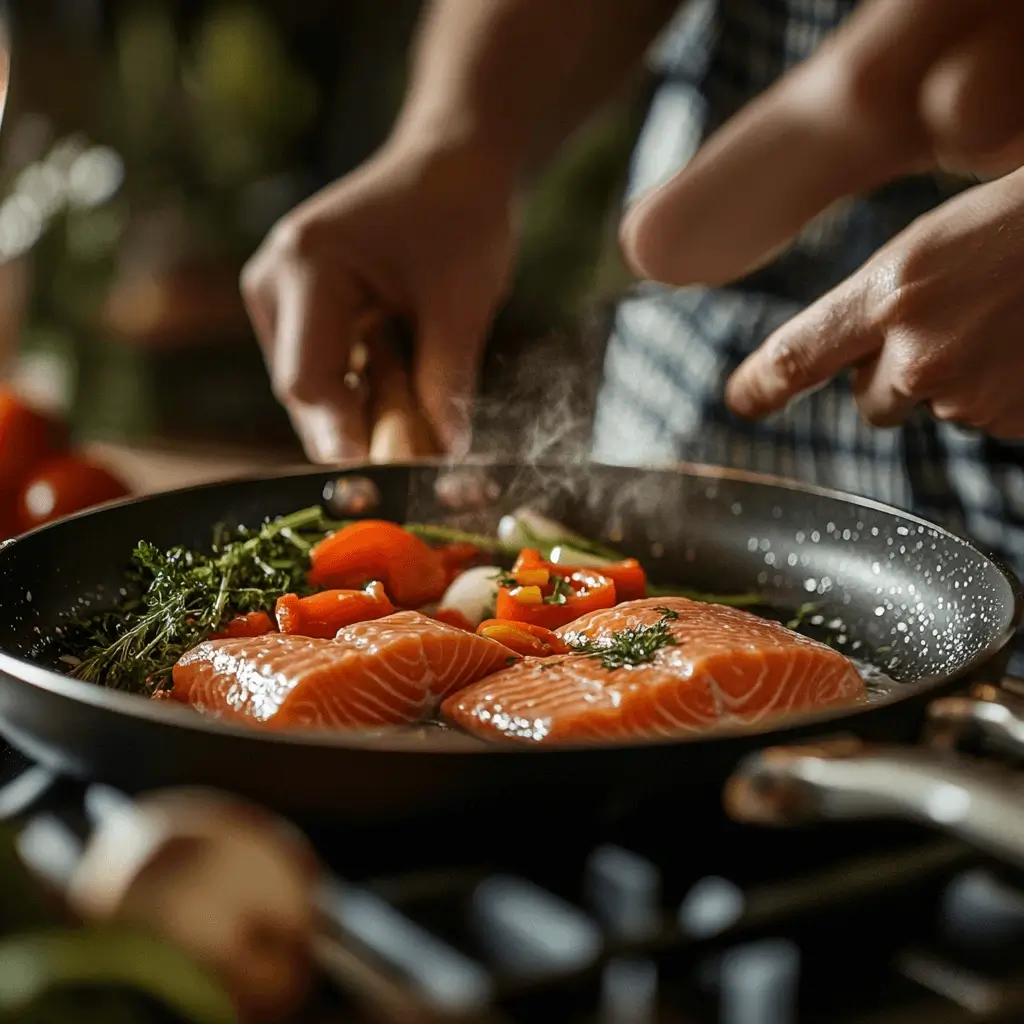
Baking – A Foolproof Way to Lock in Moisture
Baking is one of the simplest and most reliable ways to cook keta salmon while preserving its natural flavors and moisture. It allows for even cooking, making it an ideal choice for beginners and experienced cooks alike.
How to Bake Keta Salmon Perfectly:
- Preheat Your Oven
- Set your oven to 400°F (200°C). A slightly higher temperature helps seal in moisture and cook the salmon evenly.
- Prepare the Salmon
- Use a paper towel to dry the salmon fillets, removing any excess dampness.
- Place the fillets skin-side down on a parchment-lined baking sheet or in a lightly greased baking dish.
- Lightly brush the surface with olive oil or melted butter to retain moisture.
- Season with salt, pepper, garlic powder, lemon zest, and fresh herbs like dill or parsley.
- Bake the Salmon
- Roast in the preheated oven for 10-15 minutes, varying the time according to the fillet’s thickness..
- If your fillet is thicker than 1 inch, you may need an extra 2-3 minutes.
- The salmon is done when it flakes easily with a fork and reaches an internal temperature of 125-130°F (52-55°C) for medium-rare or 140°F (60°C) for well-done.
- Optional: Broil for a Golden Finish
- If you prefer a slightly crispy top, switch your oven to broil mode for the last 1-2 minutes. Watch carefully to prevent burning.
- Rest and Serve
- Rest the salmon for 2-3 minutes before serving to ensure the juices settle properly..
💡 Pro Tip: If you want an extra boost of flavor, drizzle a lemon-butter sauce over the salmon right before serving.
Grilling – Achieve a Smoky Flavor with a Perfect Char
Grilling is an excellent technique for keta salmon, as it enhances its natural flavors and adds a delicious smoky touch. Since keta salmon is lean, grilling over high heat too quickly can dry it out, so using the right approach is crucial.
How to Grill Keta Salmon:
- Preheat Your Grill
- Heat your grill to medium-high (375-400°F or 190-200°C).
- Allow the charcoal to reach a white-hot glow before placing food on the grill.
- Prepare the Salmon
- Lightly brush both sides of the salmon fillet with olive oil to prevent sticking.
- Season with salt, pepper, and optional spices like paprika, cumin, or chili flakes.
- If you want a citrusy touch, squeeze fresh lemon juice over the fillets before grilling.
- Grill the Salmon
- Place the salmon skin-side down directly on the grill grates or on a well-oiled grill pan.
- Grill for 3-5 minutes, depending on the thickness of the fillet. Avoid moving the salmon too much to ensure a good sear.
- Use a spatula to carefully flip the fillet halfway through cooking.
- The salmon is done when it reaches 125-130°F (52-55°C) and flakes easily with a fork.
- Remove and Rest
- Transfer the salmon to a plate and let it rest for 2-3 minutes to keep it juicy.
💡 Pro Tip: If you’re worried about the salmon sticking, place a layer of lemon slices on the grill and cook the salmon on top of them. This prevents sticking and infuses a fresh citrus flavor.
Pan-Searing – Achieve a Crunchy Crust with a Juicy Interior
Pan-searing is a quick and effective method to achieve a beautifully crispy skin while keeping the interior tender and flaky. It’s perfect for a restaurant-style presentation.
How to Pan-Sear Keta Salmon:
- Choose the Right Pan
- Use a heavy-bottomed pan, such as cast iron or stainless steel, to get an even sear.
- Heat the Pan Properly
- Place the pan over medium-high heat and let it get hot before adding oil.
- Add about 1 tablespoon of oil (olive oil, avocado oil, or butter) and swirl it around.
- Prepare the Salmon
- Dry the fillets with a paper towel, then season with salt and pepper.
- Lay the salmon in the hot pan with the skin facing down.
- Sear the Salmon
- Cook for 3-4 minutes without touching it to allow a crispy crust to form.
- Gently flip the fillet and cook for another 2-3 minutes on the other side.
- Finish and Serve
- If the fillet is thick, lower the heat and cook for another 1-2 minutes.
- Take it out of the pan and allow it to rest before serving.
💡 Pro Tip: For extra flavor, add butter, garlic, and fresh herbs (like rosemary or thyme) during the last minute of cooking and spoon the melted butter over the fillet.
Poaching – A Gentle Method to Retain Moisture
Poaching is an excellent way to cook keta salmon while keeping it moist and tender. This method involves gently simmering the salmon in a flavorful liquid, ensuring it stays delicate and juicy.
How to Poach Keta Salmon:
- Prepare the Poaching Liquid
- In a deep pan, add 2-3 cups of water or broth.
- Enhance the flavor with ingredients like sliced lemon, garlic, fresh dill, bay leaves, and black peppercorns.
- Bring the liquid to a gentle simmer (not boiling).
- Poach the Salmon
- Place the salmon fillet in the poaching liquid, ensuring it is fully submerged.
- Cook over low heat for 10-12 minutes, depending on the thickness of the fillet.
- The salmon should reach an internal temperature of 125-130°F (52-55°C).
- Remove and Serve
- Carefully lift the salmon out of the liquid and let it rest for a minute before serving.
💡 Pro Tip: Use white wine and vegetable broth instead of water for a more flavorful poaching liquid.
Delicious Keta Salmon Recipes
Cooking keta salmon with the right flavors and textures can elevate your dish to a whole new level. Here are three delicious recipes that bring out the best in this mild and firm fish.
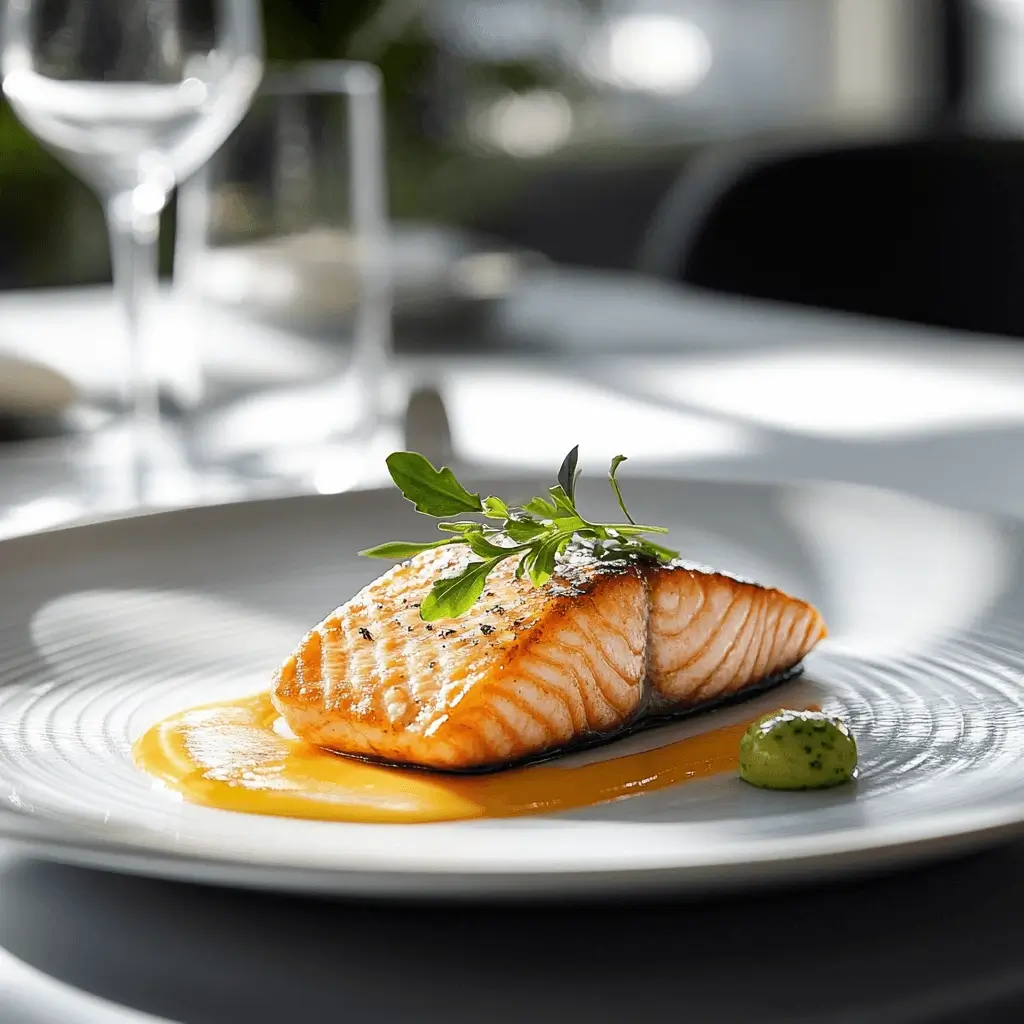
Garlic Parmesan Baked Keta Salmon
A simple yet flavorful recipe combining garlic and parmesan for a rich, crispy crust.
Baking keta salmon allows it to retain moisture while developing a delicious golden crust. The combination of garlic and parmesan adds depth to the mild flavor of keta salmon, making it a perfect dish for a quick yet satisfying meal.
Ingredients:
- 2 keta salmon fillets (about 6 oz each)
- 2 cloves garlic, minced
- 1/4 cup grated parmesan cheese
- 2 tbsp olive oil or melted butter
- 1/2 tsp salt
- 1/2 tsp black pepper
- 1 tsp lemon juice
- 1 tsp dried oregano or parsley
- 1/2 cup breadcrumbs (optional for extra crispiness)
Instructions:
- Preheat Oven – Set your oven to 400°F (200°C). Line a baking sheet with parchment paper.
- Prepare the Salmon – Pat the salmon fillets dry with a paper towel and place them on the baking sheet.
- Make the Topping – In a small bowl, mix garlic, parmesan, olive oil, lemon juice, salt, pepper, and oregano. If using breadcrumbs, mix them in for extra crunch.
- Coat the Salmon – Spread the mixture evenly over the salmon fillets, pressing gently to adhere.
- Bake – Place the salmon in the oven and bake for 12-15 minutes until the top is golden brown and the fish flakes easily with a fork.
- Serve – Garnish with fresh parsley and serve with a side of roasted vegetables or rice.
✅ Tip: Broil for the last 2 minutes for an extra crispy crust.
Sweet Chili Glazed Keta Salmon
A balance of sweet and spicy flavors that caramelize beautifully on the salmon.
This recipe uses a simple yet flavorful sweet chili glaze that enhances the natural taste of keta salmon while adding a touch of spice. It’s perfect for those who enjoy a slightly tangy and sticky coating on their fish.
Ingredients:
- 2 keta salmon fillets
- 3 tbsp sweet chili sauce
- 1 tbsp soy sauce
- 1 tbsp honey or maple syrup
- 1 tsp sriracha (optional for extra heat)
- 1 tbsp fresh lime juice
- 1 clove garlic, minced
- 1/2 tsp grated ginger
Instructions:
- Warm up the oven or grill – For baking, preheat to 375°F (190°C). If grilling, set the grill to medium-high heat.
- Make the Glaze – In a bowl, mix sweet chili sauce, soy sauce, honey, lime juice, sriracha, garlic, and ginger.
- Marinate – Brush the salmon fillets generously with the glaze and let them marinate for at least 15 minutes.
- Cook the Salmon:
- Baking – Place the salmon on a lined baking sheet and bake for 12-15 minutes, brushing with extra glaze halfway through.
- Grilling – Place skin-side down on the grill and cook for about 4-5 minutes per side, brushing with glaze occasionally.
- Serve – Sprinkle with sesame seeds and finely chopped green onions. Serve with steamed rice or stir-fried vegetables.
✅ Tip: To intensify the flavor, reserve extra glaze and drizzle over the salmon just before serving.
Sesame-Crusted Keta Salmon
A crispy sesame seed coating that adds a nutty crunch and deep flavor.
This recipe brings a unique texture to keta salmon by coating it in a crunchy sesame crust. The nuttiness from the sesame seeds complements the mild fish, and the seared exterior locks in the moisture for a juicy bite.
Ingredients:
- 2 keta salmon fillets
- 1/2 cup sesame seeds (white or black, or a mix)
- 1/4 cup panko breadcrumbs (optional for extra crunch)
- 1 egg, beaten
- 1 tbsp soy sauce
- 1 tbsp honey
- 1 tbsp sesame oil
- 1 tsp Dijon mustard
- 1 tbsp flour (for better coating adherence)
- 2 tbsp vegetable oil for frying
Instructions:
- Prepare the Coating – In a bowl, mix sesame seeds and panko breadcrumbs. In another bowl, beat the egg and mix in soy sauce, honey, sesame oil, and Dijon mustard.
- Coat the Salmon – Lightly dust each salmon fillet with flour, then dip into the egg mixture. Finally, press into the sesame seed mixture, ensuring an even coating.
- Heat the Pan – Heat vegetable oil over medium heat in a large skillet.
- Sear the Salmon – Place the fillets in the pan and cook for about 3-4 minutes per side until the sesame crust is golden brown and the fish is cooked through.
- Serve – Drizzle with a little soy sauce or teriyaki sauce and serve with a fresh cucumber salad or jasmine rice.
✅ Tip: To keep the sesame crust intact, avoid moving the fillets too much while cooking.
Tips for Serving and Pairing Keta Salmon
Once you have perfectly cooked your keta salmon, the next step is to serve it in a way that enhances its flavors and provides a well-balanced, visually appealing dish. Choosing the right side dishes, wine pairings, and presentation techniques can elevate your meal from simple to gourmet. Below are some expert tips on serving and pairing keta salmon.
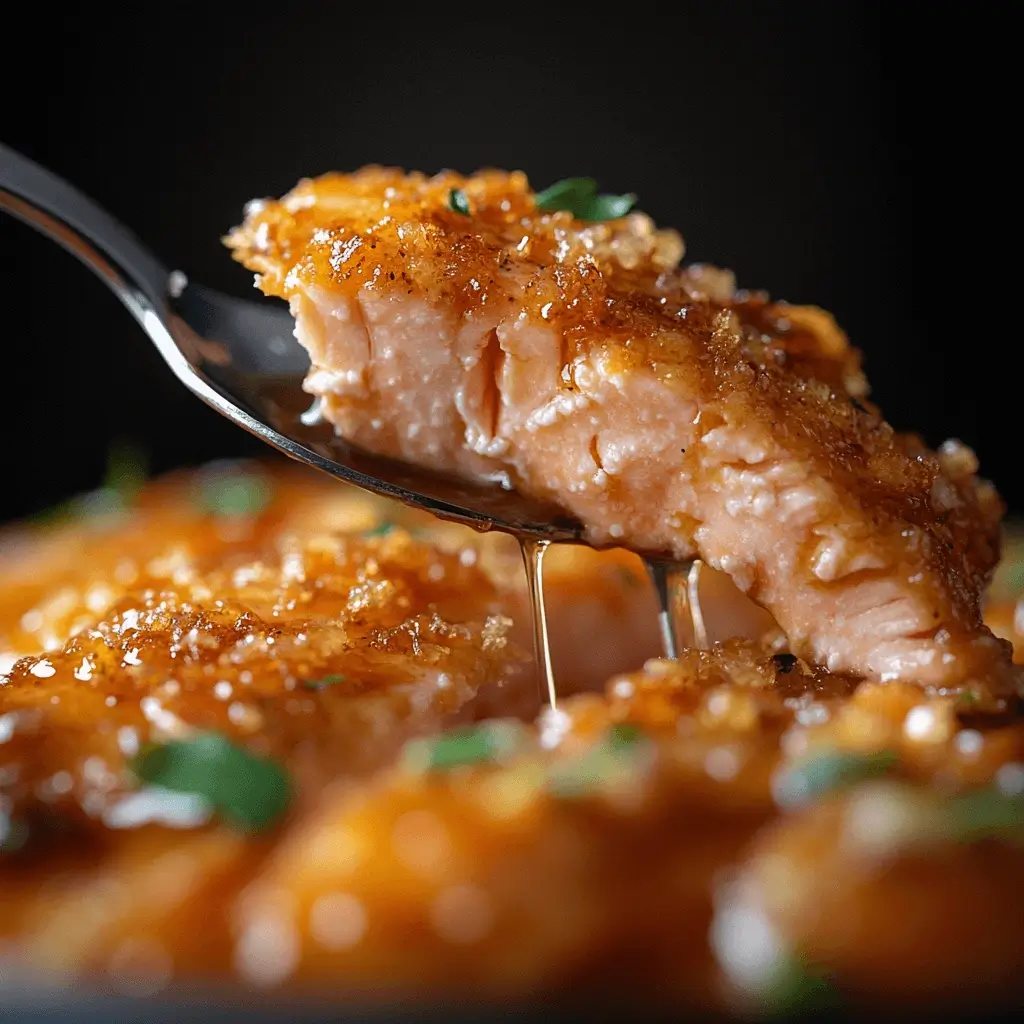
Side Dishes – Complementary Vegetables, Grains, and Salads
Keta salmon’s mild and slightly firm texture pairs well with a variety of side dishes. To create a balanced plate, consider incorporating elements that provide contrast in texture and flavor while enhancing the nutritional profile of the meal.
Vegetables
- Roasted Asparagus – The slight bitterness and crunch of asparagus complement the delicate flavor of keta salmon.
- Sautéed Spinach with Garlic – Spinach adds a rich, earthy note that balances the lean taste of keta salmon.
- Grilled Zucchini or Bell Peppers – These vegetables add a smoky sweetness that pairs well with grilled or baked salmon.
- Steamed Broccoli with Lemon Zest – The bright citrus notes from lemon enhance the salmon’s freshness.
Grains and Starches
- Quinoa or Farro – These ancient grains provide a nutty, chewy texture that complements the softness of the salmon.
- Garlic Mashed Potatoes – Creamy and buttery mashed potatoes create a comforting pairing.
- Wild Rice Pilaf – The nutty and slightly chewy texture of wild rice enhances the mild taste of keta salmon.
- Whole-Grain Couscous – Light and fluffy, couscous absorbs flavors well and makes a great base for a Mediterranean-style salmon dish.
Salads
- Citrus Arugula Salad – The peppery notes of arugula, combined with citrus slices and a light vinaigrette, provide a refreshing contrast to keta salmon.
- Cucumber and Dill Yogurt Salad – A cool and creamy salad that pairs well with grilled or seared salmon.
- Roasted Beet and Goat Cheese Salad – The sweetness of beets and the tanginess of goat cheese create a complex and delicious combination.
- Asian-Inspired Slaw – A mix of shredded cabbage, carrots, and sesame dressing adds crunch and a tangy kick.
Wine Pairings – Best Wines to Complement Keta Salmon
Pairing wine with keta salmon can enhance the flavors of both the dish and the drink. Since keta salmon has a leaner texture compared to other salmon varieties, it pairs well with crisp white wines, light-bodied reds, and dry rosés.
White Wines
- Sauvignon Blanc – Its high acidity and citrus notes brighten up the mild flavors of keta salmon.
- Chardonnay (Unoaked) – A crisp, unoaked Chardonnay complements the delicate, flaky texture of keta salmon without overpowering it.
- Pinot Grigio – Light and refreshing, Pinot Grigio’s citrus and mineral notes enhance the salmon’s natural taste.
- Riesling (Dry) – A dry Riesling with fruity undertones can balance the salmon’s savory elements, especially if paired with a slightly spicy or sweet glaze.
Rosé Wines
- Provence Rosé – A dry rosé with red berry and citrus notes pairs beautifully with baked or grilled keta salmon.
- Pinot Noir Rosé – Offers a light body with subtle fruitiness that complements the lean and firm texture of keta salmon.
Light-Bodied Red Wines
- Pinot Noir – Unlike heavier red wines, Pinot Noir’s soft tannins and bright acidity make it an excellent pairing for salmon.
- Gamay (Beaujolais) – This light and fruity red wine enhances the salmon’s umami flavors without overpowering its delicate taste.
Sparkling Wines
- Brut Champagne – Its crisp bubbles and mineral-driven taste cleanse the palate between bites.
- Prosecco – A slightly fruity and bubbly choice that works well with smoked or grilled salmon.
Presentation Ideas – Plating and Garnishing for an Appealing Meal
The way you present your dish can enhance the dining experience, making it more appetizing and visually stunning. Here are some plating and garnishing techniques to consider:
Plating Techniques
- The Rule of Thirds – Instead of placing the salmon in the center of the plate, position it slightly off-center to create a more dynamic and elegant presentation.
- Layering Ingredients – Stack or arrange the side dishes creatively; for example, place the salmon on a bed of quinoa or wild rice with vegetables arranged around it.
- Using Contrasting Colors – Brightly colored vegetables like roasted carrots, red bell peppers, or purple cabbage contrast beautifully with the salmon’s light pinkish-orange hue.
- Drizzling Sauce Elegantly – Instead of pouring sauce over the entire salmon, drizzle it artistically around the plate or create a swoosh effect with a spoon.
Garnishing Ideas
- Fresh Herbs – A sprinkle of chopped dill, parsley, or basil adds color and enhances flavor.
- Lemon or Lime Wedges – A classic touch that allows diners to add a burst of citrus as they eat.
- Microgreens – Delicate and visually appealing, microgreens add texture and a gourmet touch.
- Toasted Nuts or Seeds – Crushed pistachios, sesame seeds, or almonds can add crunch and depth of flavor.
- Edible Flowers – Small flowers like nasturtiums or pansies can make the plate look restaurant-quality.
Conclusion
Keta salmon is a versatile and nutritious seafood choice that deserves a place in every kitchen. Its mild flavor and firm texture make it suitable for a variety of cooking methods, including baking, grilling, pan-searing, and poaching. Whether you’re preparing a simple weekday meal or an elegant dinner, keta salmon adapts well to different seasonings and ingredients, allowing for endless creativity in the kitchen.
Beyond its culinary adaptability, keta salmon is also an excellent source of high-quality protein, essential omega-3 fatty acids, and important vitamins and minerals. These nutrients support heart health, brain function, and overall well-being, making it a great addition to a balanced diet. Its lower fat content compared to other salmon varieties makes it a leaner option while still providing ample nutritional benefits.
Cooking keta salmon to perfection requires the right techniques to preserve its natural moisture and enhance its delicate taste. By experimenting with different preparation styles—such as marinating, dry rubs, or pairing with flavorful side dishes you can bring out the best in this fish. Try new recipes, explore different cooking styles, and discover how keta salmon can elevate your meals while keeping them healthy and delicious.
Whether you’re a seafood enthusiast or trying keta salmon for the first time, don’t be afraid to get creative in the kitchen. With the right approach, you can turn this sustainable and nutritious fish into a satisfying dish that the whole family will enjoy. So, grab your favorite ingredients, fire up the stove or grill, and start cooking keta salmon to perfection today!ire up the stove or grill, and start cooking keta salmon to perfection today!

